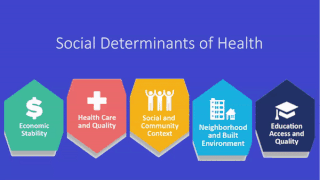Related Research Articles

Gentrification is the process of changing the character of a neighborhood through the influx of more affluent residents and businesses. It is a common and controversial topic in urban politics and planning. Gentrification often increases the economic value of a neighborhood, but the resulting demographic displacement may itself become a major social issue. Gentrification often sees a shift in a neighborhood's racial or ethnic composition and average household income as housing and businesses become more expensive and resources that had not been previously accessible are extended and improved.
The three models of deafness are rooted in either social or biological sciences. These are the cultural model, the social model, and themedicalmodel. The model through which the deaf person is viewed can impact how they are treated as well as their own self perception. In the cultural model, the Deaf belong to a culture in which they are neither infirm nor disabled, but rather have their own fully grammatical and natural language. In the medical model, deafness is viewed undesirable, and it is to the advantage of the individual as well as society as a whole to "cure" this condition. The social model seeks to explain difficulties experienced by deaf individuals that are due to their environment.

Urbanization refers to the population shift from rural to urban areas, the corresponding decrease in the proportion of people living in rural areas, and the ways in which societies adapt to this change. It is predominantly the process by which towns and cities are formed and become larger as more people begin living and working in central areas.

The term built environment refers to human-made conditions and is often used in architecture, landscape architecture, urban planning, public health, sociology, and anthropology, among others. These curated spaces provide the setting for human activity and were created to fulfill human desires and needs. The term can refer to a plethora of components including the traditionally associated buildings, cities, public infrastructure, transportation, open space, as well as more conceptual components like farmlands, dammed rivers, wildlife management, and even domesticated animals.
Agenda setting describes the "ability to influence the importance placed on the topics of the public agenda". The theory suggests that the media has the ability to shape public opinion by determining what issues are given the most attention, and has been widely studied and applied to various forms of media. The study of agenda-setting describes the way media attempts to influence viewers, and establish a hierarchy of news prevalence. Nations judged to be endowed with more political power receive higher media exposure. The agenda-setting by media is driven by the media's bias on things such as politics, economy and culture, etc. The evolution of agenda-setting and laissez-faire components of communication research encouraged a fast pace growth and expansion of these perspectives. Agenda-setting has phases that need to be in a specific order in order for it to succeed.

Environmental racism or ecological apartheid is a form of institutional racism leading to landfills, incinerators, and hazardous waste disposal being disproportionally placed in communities of color. Internationally, it is also associated with extractivism, which places the environmental burdens of mining, oil extraction, and industrial agriculture upon indigenous peoples and poorer nations largely inhabited by people of color.
In media studies, mass communication, media psychology, communication theory, and sociology, media influence and themedia effect are topics relating to mass media and media culture's effects on individuals' or audiences' thoughts, attitudes, and behaviors. Through written, televised, or spoken channels, mass media reach large audiences. Mass media's role in shaping modern culture is a central issue for the study of culture.

The social determinants of health (SDOH) are the economic and social conditions that influence individual and group differences in health status. They are the health promoting factors found in one's living and working conditions, rather than individual risk factors that influence the risk for a disease, or vulnerability to disease or injury. The distributions of social determinants are often shaped by public policies that reflect prevailing political ideologies of the area.
Community building is a field of practices directed toward the creation or enhancement of community among individuals within a regional area or with a common need or interest. It is often encompassed under the fields of community organizing, community organization, community work, and community development.
The fear of crime refers to the fear of being a victim of crime as opposed to the actual probability of being a victim of crime. The fear of crime, along with fear of the streets and the fear of youth, is said to have been in Western culture for "time immemorial". While fear of crime can be differentiated into public feelings, thoughts and behaviors about the personal risk of criminal victimization, distinctions can also be made between the tendency to see situations as fearful, the actual experience while in those situations, and broader expressions about the cultural and social significance of crime and symbols of crime in people's neighborhoods and in their daily, symbolic lives.

Socioeconomic status (SES) is an economic and sociological combined total measure of a person's work experience and of an individual's or family's economic access to resources and social position in relation to others. When analyzing a family's SES, the household income, earners' education, and occupation are examined, as well as combined income, whereas for an individual's SES only their own attributes are assessed. Recently, research has revealed a lesser recognized attribute of SES as perceived financial stress, as it defines the "balance between income and necessary expenses". Perceived financial stress can be tested by deciphering whether a person at the end of each month has more than enough, just enough, or not enough money or resources. However, SES is more commonly used to depict an economic difference in society as a whole.

Social inequality occurs when resources in a given society are distributed unevenly, typically through norms of allocation, that engender specific patterns along lines of socially defined categories of persons. It posses and creates gender cap between individuals that limits the accessibility that women have within society. The differentiation preference of access of social goods in the society brought about by power, religion, kinship, prestige, race, ethnicity, gender, age, sexual orientation, and class. Social inequality usually implies the lack of equality of outcome, but may alternatively be conceptualized in terms of the lack of equality of access to opportunity. This accompanies the way that inequality is presented throughout social economies and the rights that are skilled within this basis. The social rights include labor market, the source of income, health care, and freedom of speech, education, political representation, and participation.
Housing segregation in the United States is the practice of denying African Americans and other minority groups equal access to housing through the process of misinformation, denial of realty and financing services, and racial steering. Housing policy in the United States has influenced housing segregation trends throughout history. Key legislation include the National Housing Act of 1934, the G.I. Bill, and the Fair Housing Act. Factors such as socioeconomic status, spatial assimilation, and immigration contribute to perpetuating housing segregation. The effects of housing segregation include relocation, unequal living standards, and poverty. However, there have been initiatives to combat housing segregation, such as the Section 8 housing program.

While genetic influences are important to understanding obesity, they cannot explain the current dramatic increase seen within specific countries or globally. It is accepted that calorie consumption in excess of calorie expenditure leads to obesity; however, what has caused shifts in these two factors on a global scale is much debated.
Vulnerability refers to "the quality or state of being exposed to the possibility of being attacked or harmed, either physically or emotionally."
Nan Dirk de Graaf is a Dutch sociologist working in Nuffield College, University of Oxford. He is known for his work on social stratification, religion, political sociology, the impact of social mobility on a variety of social issues, pro-social behaviour, as well as his books.

Kelvyn Jones, is a British professor (Emeritus) of human quantitative geography at the University of Bristol. He focuses on the quantitative modelling of social science data with complex structure through the application of multilevel models; especially in relation to change and health outcomes. Uniquely he is an elected Fellow of the British Academy, the Academy of the Social Sciences and the Learned Society of Wales.
Environmental, ecological or green gentrification is a process in which cleaning up pollution or providing green amenities increases local property values and attracts wealthier residents to a previously polluted or disenfranchised neighbourhood. Green amenities include green spaces, parks, green roofs, gardens and green and energy efficient building materials. These initiatives can heal many environmental ills from industrialization and beautify urban landscapes. Additionally, greening is imperative for reaching a sustainable future. However, if accompanied by gentrification, these initiatives can have an ambiguous social impact. For example, if the low income households are displaced or forced to pay higher housing costs. First coined by Sieg et al. (2004), environmental gentrification is a relatively new concept, although it can be considered as a new hybrid of the older and wider topics of gentrification and environmental justice. Social implications of greening projects specifically with regards to housing affordability and displacement of vulnerable citizens. Greening in cities can be both healthy and just.

Transport divide refers to unequal access to transportation. It can result in the social exclusion of disadvantaged groups.
Gentrification in the United States is commonly associated with an influx of higher-income movers into historically divested neighborhoods with existing, working-class residents, often resulting in increases in property prices and investment into new developments. Displacement and gentrification are also linked, with consequences of gentrification including displacement of pre-existing residents and cultural erasure of the historic community. In the United States, discussions surrounding gentrification require critical analysis of race and other demographic data in examining the inequalities and disparities between existing residents, the community, new buyers, and developers caused by gentrification.
References
- ↑ Robert E. Park; Ernest W. Burgess; Rоderick D. McKenzie (1925). The City. Chicago: The University of Chicago Press.
- ↑ Mayhew Henry (1851). London Labor and the London Poor: A Cyclopaedia of the Condition and Earnings of Those that Will Work, Those that Cannot Work, and Those that Will Not Work. Harper.
- ↑ Parry, Marc (2012-11-05). "The Neighborhood Effect". The Chronicle of Higher Education. ISSN 0009-5982 . Retrieved 2020-04-22.
- ↑ van Ham, Maarten; Manley, David; Bailey, Nick; Simpson, Ludi; Maclennan, Duncan, eds. (2012). Neighbourhood Effects Research: New Perspectives. doi:10.1007/978-94-007-2309-2. ISBN 978-94-007-2308-5.
- ↑ van Ham, Maarten; Manley, David (2012-12-01). "Neighbourhood Effects Research at a Crossroads. Ten Challenges for Future Research Introduction". Environment and Planning A: Economy and Space. 44 (12): 2787–2793. doi: 10.1068/a45439 . ISSN 0308-518X.
- ↑ Murray, Emily T.; Head, Jenny; Shelton, Nicola; Hagger-Johnson, Gareth; Stansfeld, Stephen; Zaninotto, Paola; Stafford, Mai (2016-02-27). "Local area unemployment, individual health and workforce exit: ONS Longitudinal Study". The European Journal of Public Health. 26 (3): 463–469. doi:10.1093/eurpub/ckw005. ISSN 1101-1262. PMC 4884329 . PMID 26922299.
- ↑ Murray, Emily T.; Zaninotto, Paola; Fleischmann, Maria; Stafford, Mai; Carr, Ewan; Shelton, Nicola; Stansfeld, Stephen; Kuh, Diana; Head, Jenny (2019-04-01). "Linking local labour market conditions across the life course to retirement age: Pathways of health, employment status, occupational class and educational achievement, using 60 years of the 1946 British Birth Cohort". Social Science & Medicine. 226: 113–122. doi:10.1016/j.socscimed.2019.02.038. ISSN 0277-9536. PMID 30852391. S2CID 73725800.
- ↑ Hedman, Lina; Manley, David; van Ham, Maarten; Östh, John (2015-01-01). "Cumulative exposure to disadvantage and the intergenerational transmission of neighbourhood effects". Journal of Economic Geography. 15 (1): 195–215. doi: 10.1093/jeg/lbt042 . ISSN 1468-2702.
- ↑ Jivraj, Stephen; Murray, Emily T; Norman, Paul; Nicholas, Owen (2019-10-02). "The impact of life course exposures to neighbourhood deprivation on health and well-being: a review of the long-term neighbourhood effects literature". European Journal of Public Health. 30 (5): 922–928. doi: 10.1093/eurpub/ckz153 . ISSN 1101-1262. PMC 8489013 . PMID 31576400.
- ↑ Pearce, Jamie R. (2018-11-02). "Complexity and Uncertainty in Geography of Health Research: Incorporating Life-Course Perspectives". Annals of the American Association of Geographers. 108 (6): 1491–1498. doi:10.1080/24694452.2017.1416280. hdl: 20.500.11820/dc34486b-2da1-488e-90b2-e676cb52907c . ISSN 2469-4452. S2CID 135003476.
- ↑ Elliott, M (2000-12-01). "The stress process in neighborhood context". Health & Place. 6 (4): 287–299. doi:10.1016/S1353-8292(00)00010-1. PMID 11027954.
- ↑ Ross, Catherine E. (2000). "Neighborhood Disadvantage and Adult Depression". Journal of Health and Social Behavior. 41 (2): 177–187. doi:10.2307/2676304. JSTOR 2676304.
- ↑ Gonzalez, Michelle; Jones, Deborah J.; Kincaid, Carlye Y.; Cuellar, Jessica (2012). "Neighborhood context and adjustment in African American youths from single mother homes: The intervening role of hopelessness". Cultural Diversity and Ethnic Minority Psychology. 18 (2): 109–117. CiteSeerX 10.1.1.411.3050 . doi:10.1037/a0026846. PMID 22506815.
- ↑ Gan, Daniel R. Y. (2017). "Neighborhood effects for aging in place: a transdisciplinary framework toward health-promoting settings". Housing and Society. 44 (1–2): 73–113. doi:10.1080/08882746.2017.1393283. S2CID 149351251.
- ↑ Parry, Marc (2012-11-05). "The Neighborhood Effect". The Chronicle of Higher Education. ISSN 0009-5982 . Retrieved 2020-04-22.
- ↑ Hopkins, Daniel J.; Williamson, Thad (March 2012). "Inactive by Design? Neighborhood Design and Political Participation". Political Behavior. 34 (1): 79–101. doi:10.1007/s11109-010-9149-2. S2CID 153634625.
- ↑ The Role of Government in Education, 1955, Milton Friedman, Economics and the Public Interest, ed. Robert A. Solo, Rutgers College Press, New Jersey, accessed 30 January 2019.
- ↑ K.R. Cox, Progress in Geography, "The Voting Decision in a Spatial Context" (1969)
- ↑ N. Wrigley and R.J. Bennett (eds.), Quantitative Geography: A British View (1981).
- ↑ R.J. Johnston, Political Geography (1979), Chapter 34, and P.J. Taylor and G. Gudgin, Geography of Elections (1979), Chapter 35.
- ↑ W.L. Miller, Electoral Dynamics (1977).
- ↑ Johnston, Political Geography.
- ↑ A. Przeworski and G.A.D Soares, American Political Science Review, "Theories in Search of a Curve: A Contextual Interpretation of the Left Vote" (1971).
- ↑ Ron Johnston et al, Environment and Planning, "Neighborhood social capital and neighborhood effects" (2005).
- ↑ Cox. "The Voting Decision in a Spatial Context".
- ↑ C. Pattie and R. Johnston, Annals of the Association of American Geographers, "People Who Talk Together Vote Together: An Exploration of Contextual Effects in Great Britain" (2000).
- ↑ J. Curtice, Is Talking over the Garden Fence of Political Import? (1995).
- ↑ R. Huckfeldt, J. Sprague, and J. Levine, American Political Science Review, "Dynamics of Collective Deliberation in the 1996 Election: Campaign Effects on Accessibility, Certainty, and Accuracy" (2000).
- ↑ Nieuwenhuis, Jaap; Hooimeijer, Pieter (2016-06-01). "The association between neighbourhoods and educational achievement, a systematic review and meta-analysis". Journal of Housing and the Built Environment. 31 (2): 321–347. doi:10.1007/s10901-015-9460-7. ISSN 1573-7772. PMC 5748572 . PMID 29355196.
- ↑ Nieuwenhuis, Jaap; Hooimeijer, Pieter (2016-06-01). "The association between neighbourhoods and educational achievement, a systematic review and meta-analysis". Journal of Housing and the Built Environment. 31 (2): 321–347. doi: 10.1007/s10901-015-9460-7 . ISSN 1573-7772. PMC 5748572 . PMID 29355196.
- ↑ Nieuwenhuis, Jaap; Hooimeijer, Pieter (2016-06-01). "The association between neighbourhoods and educational achievement, a systematic review and meta-analysis". Journal of Housing and the Built Environment. 31 (2): 321–347. doi:10.1007/s10901-015-9460-7. ISSN 1573-7772.